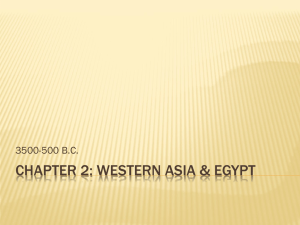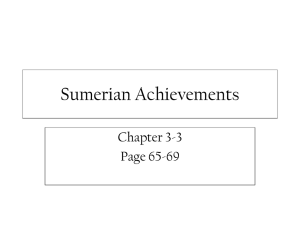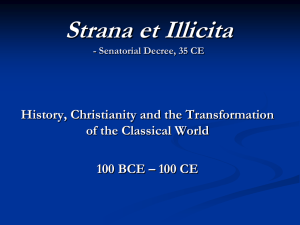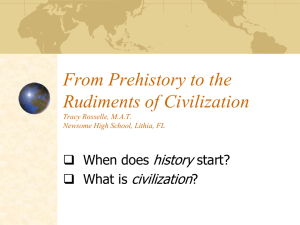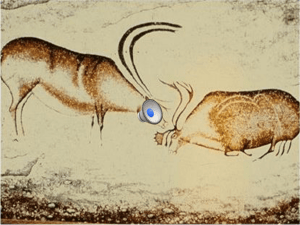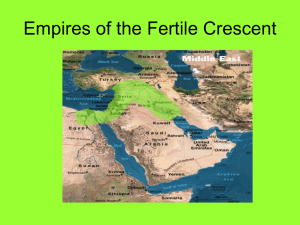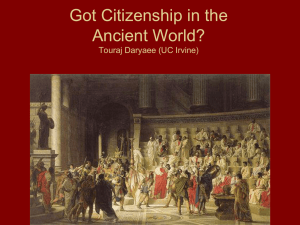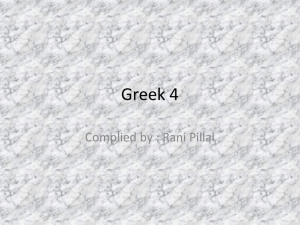AncientMesopotamianReligionNEW
advertisement
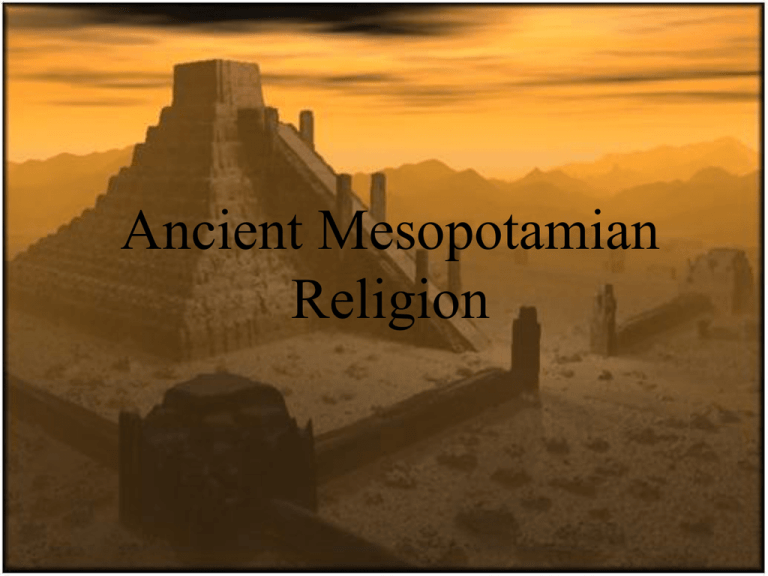
Ancient Mesopotamian Religion The western religious traditions (Judaism, Christianity, and Islam) may be traced to a complex and evolving array of religious ideas found in ancient Mesopotamia as far back as 3000 BCE. Ancient Mesopotamia roughly corresponds to modern day Iraq, northeastern Syria, and southeastern Turkey. The area known as Mesopotamia—Greek for "land between the rivers"— encompasses the territory in and around the Tigris and Euphrates rivers and their tributaries. The Sumerians settled in southern Mesopotamia between 5,000 and 3,800 BCE. Shortly after the invention of cuniform writing (around 3400 BCE), semitic-speaking people developed urban centers in Sumer, Akkad, Babylonia, and later in Assyria. 5,000-3,800 BCE: small farming communities 3,800 BCE: urbanization and a king-like ruler in Uruk, the dominant city in Sumeria at the time. 2900 BCE: Sumer had developed into a relatively stable collection of over 30 city-states. Agade The The The Uruk Jemdat Early Period Ur III Period Dynasty Nasr Period (2370-2112): (3800-3200): Period (2112-2000): Period (3200-2900): King (2900-2370): Dominance Sargon Power Slowed builds shifts Control of Uruk, down to famous Ur, shifts urbanization, urbanization where city to Kish, Agade Urand Nammu stability unitesbuilds brought Sumer andthe widespread and and tofamous the the temple region, northern Ziggurat flood construction kings regions intemple the deified, region ofatAkkad, Ur. royal Amorites tombs thereby conquer constructed the Sumerians increating Ur, and around a famous powerful 2000 King empire BCE Gilgamesh and establish rulesthe Babylonian Empire. Ziggurat Temple Built by Ur-Nammu between 2113 and 2096 for the worship of the moon god Nanna. Some Primary Sources of Mesopotamian Beliefs • Enuma Elish or Eridu Genesis (extant tablet circa 2200-2000 BCE): Sumerian cuneiform tablet that provides an account of creation and a universal flood. • Epic of Atrahasis (extant tablet, circa 17th century BCE): story of creation preserved in Assyrian and Babylonian scripts. • Tablet XI of the Epic of Gilgamesh (extant tablet, circa 12th BCE) Sumerian Religious Ideas By 3000 BCE the Sumerians had a developed cosmology and religious system. This developed out of earlier ancestor worship and the worship of heavenly bodies and forces of nature. Cosmology The Earth is a flat disk surrounded by empty space and enclosed in an over-arching heaven, forming a dome-like cover. A watery abyss surrounds the earth on all sides. The Gods Prior to the first millennium, Sumerian religious beliefs were largely polytheistic. The Sumerians believed in and worshipped multiple hierarchically arranged deities or gods. The deities in the Sumerian pantheon of gods typically began as “local” gods. Particular Sumerian cities would have their own central deity (e.g., the god An is associated with Uruk, the god Enki with Eridu). With time, certain local deities emerged as more global-type deities and the Sumerians developed an account of the origins of the gods, the universe, and humans. The chief gods of the Sumerian pantheon created the rules of Sumerian society to which all people were expected to adhere. There was a direct link between the existence of the gods and Sumerian morality. The Creation of Humans The divine origin of moral codes was itself intimately connected to Sumerian belief in the divine creation of humans. According to ancient Sumerian texts (such as Enuma Elish), humans were created so that the gods would have servants. Humans were created from the clay of the earth. “Mix the heart of the clay that is over the abyss, The good and princely fashioners will thicken the clay, You, [Nammu] do you bring the limbs into existence; Ninmah [earth-mother or birth goddess] will work above you, The goddesses [of birth] . . . will stand by you at your fashioning; O my mother, decree its [the newborn's] fate, Ninmah will bind upon it the image (?) of the gods, It is man . . . .” (Enuma Elish, Nippur Tablet) The Sumerian beliefs about the gods provide important insight into the value system of the ancient Mesopotamians. Fertility Protection in War Wisdom Reverence for the Earth Small agrarian communities would naturally develop these values. Polytheism to Monotheism Religious beliefs in the ancient Mesopotamian world underwent an interesting evolution toward a universal, central deity, as both a power in the universe and an object of worship. This was instrumental to the rise and spread of monotheism throughout the Mesopotamian world, the belief in and worship of one personal Supreme God. 1. In the third millennium there is a tendency toward a “syncretistic theology,” subsuming in one god the characteristics of many. 2. During the Akkadian period (2300 BCE), we find the deifying of kings, the divinity of a central human figure. 3. In the Babylonian creation epic Enuma Elish (circa 2000 BCE), the god Marduk is elevated to the status of the primary god, even above Enlil. The text gives Marduk fifty names that represent the qualities of distinct gods. 4. The Assyrian national god Assur, which bears an interesting conceptual resemblance to Yahweh (God) in the Old Testament, replaced Marduk around 2000 BCE. 5. By 1000 BCE monotheism was widespread through the Mesopotamian world, as illustrated especially by the monotheism of the Hebrews (in the religion of Judaism) and the Persians (in the religion of Zoroastrianism). Sources •Hilprecht, H.V. 1910. The earliest version of the Babylonian deluge story and the temple library of Nippur. The Babylonian Expedition of the University of Pennsylvania, Series D, Volume V, Fasc. 1. Philadelphia: University of Pennsylvania. •Prince, John D. and Frederick A. Vanderburgh. 1910. The new Hilprecht deluge tablet. The American Journal of Semitic Languages and Literatures 26: 303-308. •Tigay, Jeffrey H. 1982. The Evolution of the Gilgamesh Epic, Philadelphia: University of Pennsylvania Press •Jacobsen, T. 1976. The Treasures of Darkness : A History of Mesopotamian Religion. New Haven: Yale University Press. •Bottéro, J. 2004. Religion in Ancient Mesopotamia. Chicago: University of Chicago Press. •Lambert, W.G. and A.R. Millard. 1999. Atrahasis: The Babylonian Story of the Flood, Eisenbrauns. •Kramer, Samuel Noah. History Begins at Sumer. Garden City, N.Y.: Doubleday / Anchor, 1959. •Harris, Stephen L. 2011. Understanding the Bible. 8th edition. New York: McGraw Hill. See chapter 3, “Ancient Near East.”

